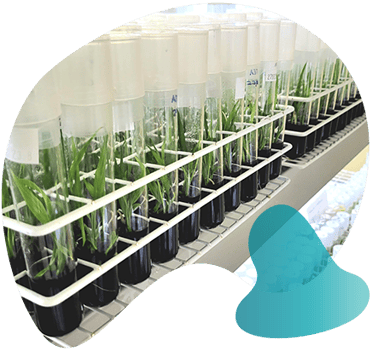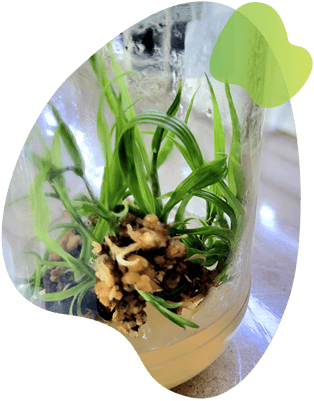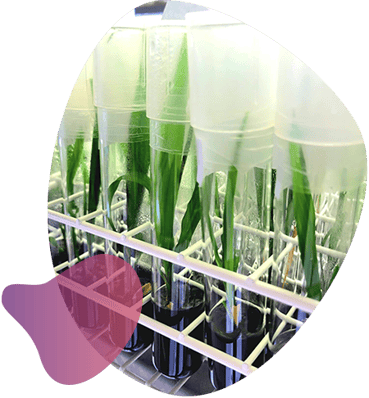Time to read: 6 minute read
Originally published : Tue, May 30, 2023 @ 4:33 PM
Updated : Thu, June 1, 2023 @ 4:09 PM
Oil palm, Elaeis guineensis Jacq., is the most productive oil crop in the world1 supplying around 40% of all globally traded vegetable oils. It is the main agricultural export of Malaysia and Indonesia, who account for 82% of global palm oil production. The industry provides employment for 721,000 small holders and labourers in Malaysia and four million in Indonesia.2 Over three billion people rely on palm oil as a key dietary component, and it is also used in a wide variety of non-food ingredients.3
The challenges for palm oil production
 Industrial palm oil production faces increasing pressure from changing climate conditions, emerging and existing threats from pests and diseases and the rapidly growing demand for yield and nutrient profile of palm oil from restricted land resources. To add to the challenge, oil palm cultivation within conventional breeding programmes takes about 12 years for the first generation and 40 years for the next four generations, which significantly delays the development of novel traits or variants.4,5
Industrial palm oil production faces increasing pressure from changing climate conditions, emerging and existing threats from pests and diseases and the rapidly growing demand for yield and nutrient profile of palm oil from restricted land resources. To add to the challenge, oil palm cultivation within conventional breeding programmes takes about 12 years for the first generation and 40 years for the next four generations, which significantly delays the development of novel traits or variants.4,5
Although significant improvements have been achieved in commercially important traits through conventional and marker-assisted breeding.6 The application of novel gene-editing technology can provide opportunities to accelerate and enhance breeding programs in oil palm.7
How CRISPR can help meet these challenges
The investigation of gene function and the precise modification of DNA sequences in the genome has been significantly advanced by the implementation of systems involving CRISPR and CRISPR-associated nucleases such as Cas9. It is seen as a powerful tool in the race for crop performance improvement across a range of traits to meet the challenges of global food supply. Introducing a new trait into an existing elite variety using gene-editing to modify genes of interest can reduce the time to market by around two-thirds.8
By precise targeting of trait-controlling regions within a selected variety, the CRISPR/Cas approach eliminates accompanying genomic drift usually introduced from trait donor lines during conventional breeding. Because of that, CRISPR/Cas cuts the need for backcrossing rounds, thereby significantly reducing the time needed to breed new crop varieties.
 Sime Darby Plantation (SDP) is one of the key players in food production in Southeast Asia, particularly in palm oil supply. It adopts and develops cutting-edge technologies in its drive towards sustainable precision agriculture. According to Dr Wan-Chin Yeap, Principal Scientist at Sime Darby Technology Centre: “We strongly believe that CRISPR is a powerful tool to revolutionise plant breeding and food technology to achieve food security for the growing population. Apart from enhancing the food crops agronomic traits, nutritional properties, food shelf life etc, CRISPR is also an important tool to reduce greenhouse gas emissions from agriculture and forest tree conservation for environmental sustainability”. When asked if CRISPR can help oil palm or other crops adapt to climate change, she replied: “Absolutely. Crop productivity and growth are generally affected by climate change, while oil palm yield is critically affected by water stress (low rainfall) and rising temperature. CRISPR gene editing is necessary to accelerate the development of new crop cultivars with increasing tolerance to abiotic stresses e.g. temperature change or extreme climates and water scarcity, and to improve carbon sequestration to prevent further carbon dioxide build-up in the atmosphere. Moreover, food waste is another contributing factor to increasing atmospheric CO2. CRISPR editing could be used to edit crops to improve crop defence mechanisms and to extend fruits/ vegetables shelf life”.
Sime Darby Plantation (SDP) is one of the key players in food production in Southeast Asia, particularly in palm oil supply. It adopts and develops cutting-edge technologies in its drive towards sustainable precision agriculture. According to Dr Wan-Chin Yeap, Principal Scientist at Sime Darby Technology Centre: “We strongly believe that CRISPR is a powerful tool to revolutionise plant breeding and food technology to achieve food security for the growing population. Apart from enhancing the food crops agronomic traits, nutritional properties, food shelf life etc, CRISPR is also an important tool to reduce greenhouse gas emissions from agriculture and forest tree conservation for environmental sustainability”. When asked if CRISPR can help oil palm or other crops adapt to climate change, she replied: “Absolutely. Crop productivity and growth are generally affected by climate change, while oil palm yield is critically affected by water stress (low rainfall) and rising temperature. CRISPR gene editing is necessary to accelerate the development of new crop cultivars with increasing tolerance to abiotic stresses e.g. temperature change or extreme climates and water scarcity, and to improve carbon sequestration to prevent further carbon dioxide build-up in the atmosphere. Moreover, food waste is another contributing factor to increasing atmospheric CO2. CRISPR editing could be used to edit crops to improve crop defence mechanisms and to extend fruits/ vegetables shelf life”.
Developing CRISPR techniques
 SDP are one of the global leaders in developing these gene editing methods for oil palm. Dr Yeap and her colleagues have recently reported the successful development of a proof-of-concept CRISPR/Cas9 gene-editing system for African oil palm, E. guineensis Jacq.7 This critical study is a milestone on the road to development of efficient gene-editing system for palm species.
SDP are one of the global leaders in developing these gene editing methods for oil palm. Dr Yeap and her colleagues have recently reported the successful development of a proof-of-concept CRISPR/Cas9 gene-editing system for African oil palm, E. guineensis Jacq.7 This critical study is a milestone on the road to development of efficient gene-editing system for palm species.
Their investigation focused on the development of a transient oil palm protoplast assay to rapidly evaluate the cleavage efficiency of CRISPR/Cas9 mutagenesis and the generation of stable transformed oil palms using biolistic particle bombardment in immature embryos. Some of the key limitations for achieving efficient CRISPR editing in oil palm are common with other plant systems and include the DNA delivery method, low efficacy of genetic transformation system and inefficient tissue culture regeneration processes. To overcome these limitations, the authors have tested various DNA delivery methods, oil palm tissues for transformation and regeneration methods. They have achieved up to 19.5% transformation efficiency using particle bombardment into oil palm zygotic embryos. Optimisation is still on-going to enhance the DNA delivery method for higher transformation efficiency in oil palm.
Two genes were targeted in this study along with multiple guide RNAs (5 for each gene) designed for various sites of these genes. For the phytoene desaturase (EgPDS) gene involved in carotenoid synthesis, the observed CRISPR/Cas9 cleavage frequency was up to 25.49% and mutation efficiency of 62.5-83.33% through small DNA insertions and deletions (indels), and nucleotide substitutions, resulting in generation of transgenic oil palm shots with chimeric albino phenotypes.
 The precision of the CRISPR/Cas9 system was further tested in targeting the second gene - brassinosteroid-insensitive1 (EgBRI1) gene, a defective form of which results in dwarf plant phenotype. Nucleotide substitutions and indels in EgBRI1 lead to premature necrosis shoots and stunted phenotype mutants.
The precision of the CRISPR/Cas9 system was further tested in targeting the second gene - brassinosteroid-insensitive1 (EgBRI1) gene, a defective form of which results in dwarf plant phenotype. Nucleotide substitutions and indels in EgBRI1 lead to premature necrosis shoots and stunted phenotype mutants.
Their results showed that effective and efficient editing of genes using the CRISPR/Cas9 system can be achieved in oil palm by optimising the selection of an efficient guide RNA to direct Cas9 to the target sequence and DNA delivery methods. The authors thus believe that this newly designed strategy will enable new routes for genetic improvement in oil palm and related species.
Dr Yeap commented: “We will focus on using CRISPR for gene function study to improve agronomic traits in oil palm, e.g. abiotic stress tolerance against climate change, fruit oil biosynthesis, Ganoderma disease defense and harvesting traits such as dwarf and long stalk. Currently we are using CRISPR as a tool to study functions of oil palm genes, regulators and natural genetic variants for traits including abiotic stress response, fruit oil biosynthesis, oil compositions and harvesting traits.
The edited palms are currently still in the laboratory under the in vitro tissue culture process. Gene editing is still regulated under the GMO framework of Biosafety act in Malaysia, thus the deployment of gene editing in developing commercial edited oil palm is constrained at the moment. Hence, the edited palm plants are transplanted and maintained in the transgenic greenhouse for further phenotypic analysis once they are ready”.
Looking to the future
 Dr Yeap and her team believe that CRISPR gene-editing technology will bring many benefits to improvement of oil palm commercial output: “CRISPR accelerates the gene function study in oil palm to better understand the underlying mechanism for oil palm agronomic traits. CRISPR can provide opportunities to accelerate and enhance oil palm breeding programmes; it enables the introduction of natural genetic variations into elite oil palm at an accelerated timeline and high precision than traditional plant breeding techniques”.
Dr Yeap and her team believe that CRISPR gene-editing technology will bring many benefits to improvement of oil palm commercial output: “CRISPR accelerates the gene function study in oil palm to better understand the underlying mechanism for oil palm agronomic traits. CRISPR can provide opportunities to accelerate and enhance oil palm breeding programmes; it enables the introduction of natural genetic variations into elite oil palm at an accelerated timeline and high precision than traditional plant breeding techniques”.
Dr Yeap and her team conducted various tests to confirm and validate the targeted edits. They included:
- T7 endonuclease I enzymatic mismatch cleavage assays to detect the presence of mutation triggered by CRISPR.
- PCR-amplification of target sequences followed by Sanger sequencing to confirm the presence of indels.
- Gene or protein expression analysis to confirm the effect of editing on the target gene transcription or translation.
- Phenotypic alterations on edited plants.
Simple and fast DNA extraction
SDP use LGC Biosearch Technologies’ QuickExtract™ DNA Extraction Solution for the isolation of genomic DNA from both transformed protoplasts and transgenic oil palm mutants. Extracted DNA is then used for either absolute quantitative real-time PCR or Sanger sequencing of PCR-amplified target sequences. Dr Yeap commented on their choice of DNA extraction chemistry: “QuickExtract is suitable for the extraction of DNA from oil palm protoplasts and older leaves from immature oil palm seedlings. We use QuickExtract as a replacement when the DNA isolation from difficult tissue is unsuccessful using Plant Direct PCR kit. QuickExtract is affordable, technically simple and fast compared to the spin column DNA plant mini kit”.
Further reading
Improving the sustainability of oil plam breeding programmes using marker-assisted selection
Dr Yeap’s research paper on CRISPR and oil palm
About the author
Dr Maria Kolesnikova-Allen worked on the development of the NNHB 67 pearl millet variety with enhanced downy mildew resistance while at ICRISAT, assessed the diversity of cocoa germplasm across West Africa and implemented the use of molecular markers for crops like cowpea, banana, plantain, yams in IITA and developed genomic and molecular marker resources for rubber tree at the Malaysian Rubber Board. Maria is a Commercial Application Scientist at Biosearch Technologies working with a wide range of agriculture clients across Europe, Africa, the Far East and Asia Pacific. Maria’s mission is to share her knowledge and expertise to help breeders adopt biotechnological approaches to mitigate the effects of climate change and meet the world’s ever increasing food demand.
References
- Hashim, Z; Muhamad, H; Chan, KW; Choo, YM and Wahid, MB (2010). Life cycle assessment for oil palm fresh fruit bunch production from continued land use for oil palm planted on mineral soil (Part 2). J. Oil Palm Res., 22: 887-894
- EPRS | European Parliamentary Research Service EN, Author: Martin Russell, Members' Research Service PE 614.706 https://www.europarl.europa.eu/RegData/etudes/ATAG/2018/614706/EPRS_ATA(2018)614706_EN.pdf
- Murphy, D.J., Goggin, K. & Paterson, R.R.M. Oil palm in the 2020s and beyond: challenges and solutions. CABI Agric Biosci 2, 39 (2021). https://doi.org/10.1186/s43170-021-00058-3
- Ahmad Malike, F. et al., 2019. Oil palm (Elaeis spp.) breeding in Malaysia. Advances in Plant Breeding Strategies: Industrial and Food Crops: Volume 6, pp.489-535.
- John Martin, J.J.; Yarra, R.; Wei, L.; Cao, H. Oil Palm Breeding in the Modern Era: Challenges and Opportunities. Plants 2022, 11, 1395. https://doi.org/10.3390/plants11111395
- Soh, A. C., Mayes, S., and Roberts, J. A. (2017). Oil Palm Breeding: genetics and Genomics. Atlanta: CRC Press
- Yeap, W.-C., Norkhairunnisa, K. C. M., Norfadzilah, J., Muad, M. R., Appleton, D. R., and Harikrishna, K. (2021). An efficient clustered regularly interspaced short palindromic repeat (CRISPR)/CRISPR-associated protein 9 mutagenesis system for oil palm (Elaeis guineensis). Front. Plant Sci. 12, 773656–773656. https://doi.org/10.3389/fpls.2021.773656
- Dhugga, KS (2022) Gene Editing to Accelerate Crop Breeding. Front.PlantSci.13:889995. http://doi.org/10.3389/fpls.2022.889995

